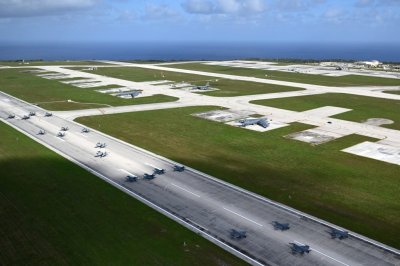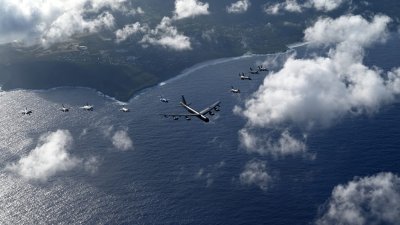The combined airpower of allied air forces was on full display this week at Andersen Air Force Base, Guam, reaching a climax with the six-nation elephant walk.
It took place as U.S. defense partners face mounting pressure in a number of West Pacific hot spots. Relations between South Korea and an increasingly hostile North are at their worst in decades. Meanwhile, Japan and the Philippines continue to grapple with territorial disputes with an expansive China in the East and South China seas, respectively.
Some 700 service members from Japan, South Korea, France, Australia, and Canada joined about 1,700 U.S. Air Force, Marine, and Navy personal in the 2024 edition of the annual Cope North exercise, the largest of the U.S. Air Force's Pacific Air Forces (PACAF) command's annual drills.
Participating air forces took part in an elephant walk involving 35 aircraft, according to the press release PACAF published on Tuesday.
The roster included 21 planes from the U.S. Air Force and Marine Corps, 10 from the Japanese Air Self-Defense Force, two from the French Air and Space Force, and one each from the Australian and South Korean air forces, according to a spokesperson for the Andersen Air Force Base's 36th Wing, per Air & Space Forces Magazine.
Newsweek reached out to PACOM and China's Ministry of Foreign Affairs with a written request for comment.
"It was a surreal experience to be a part of the taxi formation alongside our international partners. Everyone's professionalism and eagerness to work together will propel our war-fighting capabilities in the Pacific," Air Force Master Sgt. Steven Hood, of the 756th Air Refueling Squadron, was quoted as saying.
Cope North activities spanned six airfields and two West Pacific islands—beyond Guam. Photos show a nuclear-capable U.S. B-52 Stratofortress bomber flying over the Northern Marianas islands Tinian and Saipan while flanked by an electronic warfare aircraft, a search-and-rescue plane, and a variety of American and Japanese fighter jets.




"Cope North enhances U.S. relations and interoperability with regional allies and partners by fostering the exchange of information and refining shared tactics, techniques, and procedures," the PACAF statement said, adding that the aim of the exercise was interoperability among participating air forces with an eye on regional security.
The U.S. and Japan are fresh from January's multi large deck naval exercise involving two Nimitz-class supercarriers, the USS Theodore Roosevelt and Carl Vinson, Japanese Hyugu-class destroyer the JS Ise, and nine supporting ships in the Philippine Sea.
The Carl Vinson and Theodore Roosevelt are still in the area, a Navy spokesperson confirmed to Newsweek, bringing the total number of U.S. supercarriers in the U.S. Seventh Fleet's area of operations to three, including the forward-deployed Ronald Reagan.

Uncommon Knowledge
Newsweek is committed to challenging conventional wisdom and finding connections in the search for common ground.
Newsweek is committed to challenging conventional wisdom and finding connections in the search for common ground.
About the writer
Micah McCartney is a reporter for Newsweek based in Taipei, Taiwan. He covers U.S.-China relations, East Asian and Southeast Asian ... Read more
To read how Newsweek uses AI as a newsroom tool, Click here.






